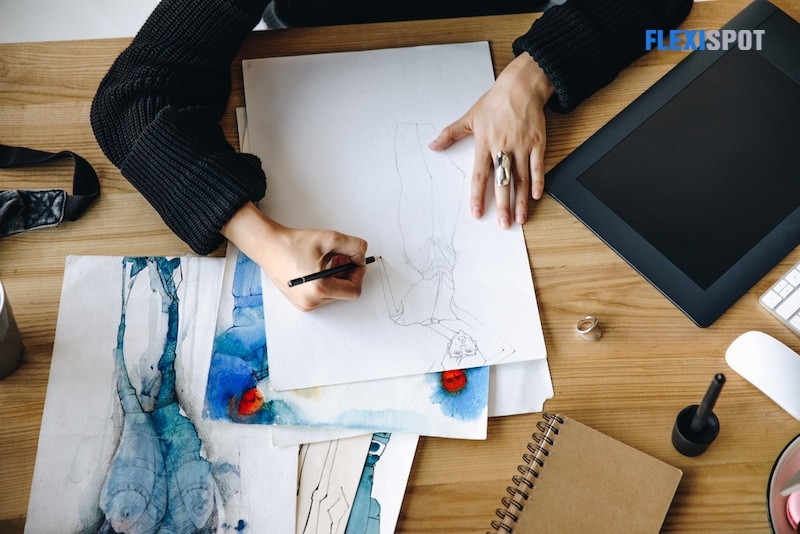Not everyone is born to be gifted with their hands in drawing, sketching, or painting. This doesn’t mean, however, that drawing can’t be taught or learned, especially to that visual artist with a million ideas on her head of what her pen can create.
Even the greatest of the great want to continuously improve their drawing performance. One has to know that aside from talent or interest, drawing is a skill, and knowing the techniques can help an aspiring artist or a seasoned expert improve their craft even more.
Here are some tips you can follow to improve your drawing skills and express yourself better through this art form:
1. Sketch every day.
Make a routine out of drawing, whether it be to release stress or stimulate your creativity. When you draw every day, you become better at it and your ideas will also flow more freely when you draw on a daily basis. This is especially true for those who are just starting out in a drawing. Ideas may not come by so quickly if you’re just a beginner but a good starting point is to observe and draw what you see.
2. To prepare yourself for more complex work, in the long run, warm up your hands before drawing.
This will improve speed and coordination in the long term. It really depends on the artist what gets their hands and arms ready to draw. You’ll understand your tools better if you follow number one and you’d know overtime where and what your hands and arms are most comfortable in.
There are many exercises you can try for your drawing skill to eventually level up. One of these is drawing free-form textures. Skillshare suggests getting a piece of paper, a fine-point drawing pen, and a broad surface area. Fill the page with clusters of different textures and arrangements in the shortest amount of time. Don’t worry about how it looks like because in this exercise, what matters is how many you’ll be able to draw.
Another exercise suggested by Skillshare is to have a timer for five minutes and doodle just small shapes and lines on the top left corner of your paper. The focus should be on your pace which must be quick in creating various textures. Look for patterns in the doodle after the five minutes are up.
One more exercise is a continuous line drawing. It helps an artist to disassociate drawing from perfection. The creative expression must be the goal because after all, perfect is not achievable. All you have to do is pick up a medium-point felt-tipped pen, choose a subject, and draw on a blank sheet without lifting the pen until you’re done.
3. Think like an architect and draw from a perspective.
If you’re not familiar with what perspective is at drawing, it simply means the angle of how you see and view your subject. This will vary depending on a number of factors such as the size of your subject, your proximity to the subject, your standing or sitting form, etc.
Don’t stress if you don’t get it quickly because perspective is one of the hardest drawing skills to master. But then again, consistent regular practice is all you need to train your mind and exercise your hands to execute drawing what you see. You may try the gridded room exercise where you would need to rely on and use guide points to shape your idea of the perspective. A ruler will definitely come in handy for this one and a table that you can tilt anytime to adjust angles.
4. Focus on proportion.
Perspective and proportion go hand-in-hand to make your drawings better and more realistic. If perspective is the viewing angle, then the proportion is the scale of your subject that depends on the relationship between height, width, and depth as well as your perspective.
To practice proportion, work on drawing with grids. Choose your subject then print it out on a piece of blank paper. Draw vertical and horizontal lines over the image (note: distance is commonly one inch wide apart). Label the horizontal lines with numbers and the vertical ones with letters. Put it beside a blank sheet where you will copy the grid paper. Look at the coordinates (the letter and number) and copy them on your paper for drawing. This is how you compartmentalize the drawing to accurately draw the right proportions. Once you’ve mastered this, you’ll eventually be drawing with grids that only exist on your head.
5. Practice drawing shapes.
When you’ve mastered drawing shapes, you’ll be able to create intricate and detailed patterns and fill pieces of paper with beautiful abstract art. With a trained eye that comes with practice, you could look at a photograph or at your subject and be able to identify the basic shapes of their foundations.
One fun exercise is to cut images from magazines and using a black marker, trace all the shapes that you can find in the photograph. The more you practice this, the more you train your eyes to see shapes in the natural world that will help improve your drawing skill.




